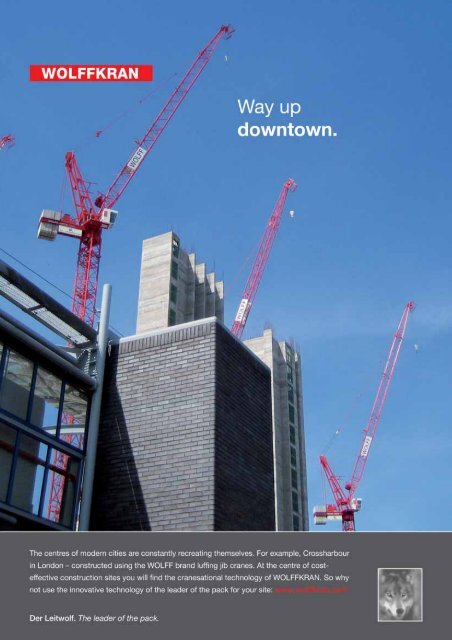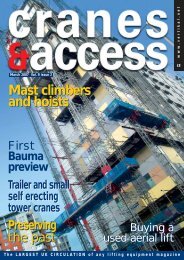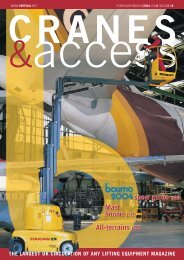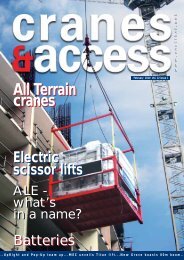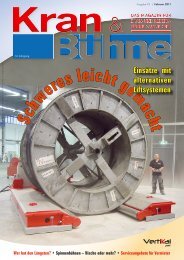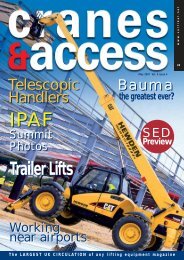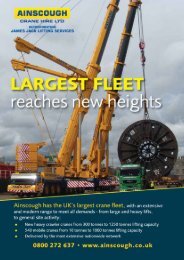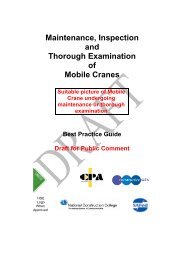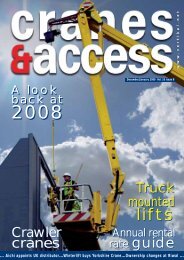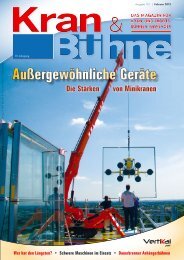You also want an ePaper? Increase the reach of your titles
YUMPU automatically turns print PDFs into web optimized ePapers that Google loves.
Are big<br />
<strong>crawler</strong>s<br />
too big?<br />
Despite the hammering taken by the new crane market<br />
over the past two years, one area that has remained<br />
surprisingly buoyant is <strong>crawler</strong> <strong>cranes</strong>, in particular<br />
the larger end of the sector, as well as the<br />
growing number of ‘big lift’ alternatives.<br />
The past few years have seen quite<br />
a change in the crane market with<br />
sales in some sectors going literally<br />
from boom to bust. Large <strong>crawler</strong><br />
<strong>cranes</strong> have however performed<br />
well, with sales driven by the global<br />
demand from large infrastructure<br />
and power projects. For these<br />
massive contracts we are talking<br />
capacities from 500 to more than<br />
3,000 tonnes. This size of crane was<br />
previously limited to the established<br />
global players such as Liebherr,<br />
Terex and Manitowoc and specialist<br />
producers such as Lampson.<br />
Kobelco has also been pushing<br />
further into this area and in the<br />
past couple of years a growing<br />
influx of big <strong>crawler</strong> <strong>cranes</strong> from<br />
Chinese manufacturers.<br />
Manitowoc has the strongest or<br />
longest pedigree in this sector,<br />
having built-up a huge reputation in<br />
the 1960s and 1970s with its 150<br />
ton 4000W VICON (Variable<br />
Independent Control) and then the<br />
legendary 300 tonne capacity<br />
4100W VICON Series 2 or Series<br />
3 with ringer attachments.<br />
The 4100W ringer can out lift many<br />
of the modern day <strong>cranes</strong> by more<br />
than 100 percent at long radii,<br />
managing for example 35 tonnes<br />
on a 300ft boom at 210ft radius.<br />
It is no surprise therefore that these<br />
<strong>cranes</strong> were so popular and still<br />
have a certain following today.<br />
By the early to mid 1980’s as a<br />
major construction slump took<br />
ALE, the global heavy transport and lifting company, has successfully<br />
completed the inaugural lift of its new Terex Demag CC8800-1 crane.<br />
With a total weight of 1,457.1tonne, the lift, which took place in Sines,<br />
Portugal, is the heaviest lifted with a CC8800-1 crane, and is believed<br />
to be the heaviest lift ever in the field by a Terex Demag crane.<br />
c&a<br />
hold, the Manitowoc 4100 and 4600<br />
series began to look dated against<br />
the heavy Demag <strong>crawler</strong> <strong>cranes</strong><br />
such as the 300 tonne CC2000<br />
series (launched 1979/80) and<br />
Liebherr’s emerging big <strong>crawler</strong><br />
crane line-up led by the LR1600.<br />
The CC2000 was the improved,<br />
larger capacity successor to the<br />
short-lived 250 tonne CC1200 and<br />
became the basis of the CC2400,<br />
CC2600 and the CC2800-1 of today.<br />
On top of this Link Belt had teamed<br />
up with Sumitomo and was pushing<br />
its all-hydraulic HyLab <strong>cranes</strong> at the<br />
smaller end of the market. The<br />
combination hit Manitowoc hard,<br />
and given that it also had its<br />
shipbuilding and ice making<br />
divisions to fall back on, the<br />
company almost quit crane-making<br />
for good, limiting production to<br />
more profitable build-to-order<br />
contracts, while supporting its<br />
existing population. While many of<br />
its dealers and competitors thought<br />
that this was the beginning of the<br />
end for Manitowoc <strong>cranes</strong>, it was<br />
working on a completely new, all<br />
hydraulic crane line, resulting in<br />
the launch of the Manitowoc M250,<br />
a new, easy to transport, quick to<br />
erect 250 ton crane in 1992. It was<br />
exceptionally well received and<br />
not only put Manitowoc back on<br />
the crane map, but made it strong<br />
enough after a few years to go<br />
shopping for acquisitions, adding<br />
Potain tower <strong>cranes</strong> and then Grove<br />
telescopic <strong>cranes</strong> in 2002, taking it<br />
from an ‘also-ran’ to one of the top<br />
three international crane producers.<br />
When it comes to the big <strong>crawler</strong><br />
crane market though, the company<br />
has not managed to recreate the<br />
position that the Manitowoc brand<br />
<strong>crawler</strong> <strong>cranes</strong><br />
Manitowocs<br />
31000 on test<br />
had in Europe during the hay-day<br />
of the 4100’s – or at least not yet.<br />
In the past few years Demag,<br />
(now Terex) has had its fellow<br />
countryman Liebherr breathing<br />
down its neck in the big <strong>crawler</strong><br />
crane market to the point where<br />
Liebherr has arguably unseated it<br />
as the dominant player? Both<br />
though need to keep an eye on<br />
Kobelco which has been taking an<br />
increasingly larger share of the<br />
market in which it competes.<br />
Then there is the growing presence<br />
(threat?) from China with Sany,<br />
Fuwa and Zoomlion recently<br />
launching new <strong>cranes</strong> up to<br />
1,250 tonnes.<br />
The new<br />
Sennebogen 7700<br />
with a 370 tonne<br />
test load<br />
August/September 2010 <strong>cranes</strong> & access 47
<strong>crawler</strong> <strong>cranes</strong> c&a<br />
Oriental competition<br />
Established in 1904 Fuwa is the<br />
oldest crane manufacturer in China.<br />
With increasing sales both at home<br />
and abroad, the company is<br />
continually expanding its<br />
manufacturing facilities, currently<br />
adding a new plant near Shenyang.<br />
A few months ago it announced the<br />
new 1,250 tonne QUY1250 which<br />
will be seen at Bauma China in<br />
Shanghai later this year.<br />
Powered by a Cummins engine and<br />
Rexroth hydraulics it is rated at<br />
1,250 tonnes at eight metres radius<br />
The 3,200 tonne<br />
Terex CC8800-1<br />
Twin at its launch<br />
in 2007<br />
with the main boom in super lift<br />
configuration. Maximum boom/jib<br />
configuration is 96 metres of boom<br />
plus a 108 metre luffing jib.<br />
Although not confirmed, it is<br />
thought that this crane will be<br />
joined by an 8-900 tonner later<br />
this year, filling in between its<br />
previous largest 500 tonner and<br />
the new QUY1250.<br />
About a year ago Chinese crane<br />
manufacturer Sany, unveiled its<br />
1,000 tonne <strong>crawler</strong>, the SCC 10000<br />
which should now be in production.<br />
The new crane followed closely on<br />
48 <strong>cranes</strong> & access August/September 2010<br />
Liebherr’s new LR<br />
1300 is currently<br />
being built.<br />
the heels of a 900 tonner and offers<br />
a maximum main boom of 120<br />
metres, with a total boom and jib<br />
combination of 192 metres.<br />
But these are not the only Chinese<br />
manufacturers producing sizeable<br />
<strong>crawler</strong> <strong>cranes</strong>. XCMG, Foton Lovol<br />
and Zoomlion are all producing 500<br />
tonne plus <strong>cranes</strong> and looking to<br />
increase capacities further although<br />
most, if not all large capacity<br />
Chinese <strong>crawler</strong> <strong>cranes</strong> remain in<br />
China working on the larger<br />
infrastructure and power contracts.<br />
The speed with which these<br />
companies have developed such<br />
big <strong>cranes</strong> is something close to<br />
frightening. Even with the massive<br />
computing power and design aids<br />
that today’s crane engineers have at<br />
their fingertips, the development of<br />
such big <strong>cranes</strong> takes the<br />
international manufacturers - who<br />
have years of experience in the<br />
sector - a very long time. This<br />
applies to Americans, Germans and<br />
the Japanese so it’s not a question<br />
of old world or western inefficiency.<br />
The question that many are asking<br />
is what do these new entrants<br />
know? Is it the number of people<br />
they can throw at the task?<br />
Or is it that they don’t know the<br />
depth of design work required?<br />
This uncertainty will surely curb<br />
sales to the major international<br />
lifting specialists. However if, as<br />
one assumes there is a substantial<br />
price advantage, they could appeal<br />
to contractors in the developing<br />
world and as such pose a challenge<br />
to the established producers.
The brilliant CC2000<br />
Terex/Demag owes a great deal of<br />
its success in the big <strong>crawler</strong><br />
crane market to the brilliance of<br />
the original 1980s CC2000 design.<br />
Since its initial success it has taken<br />
the basic building blocks from that<br />
model and extended it in every way<br />
possible to the point where the<br />
current CC2800 probably takes the<br />
design as far as it can go. Expect a<br />
new 750 tonne model from Terex<br />
soon and if it has done its job,<br />
it will become the base for a new<br />
product range to build on the<br />
CC2000 pedigree. For Terex, this is<br />
essential if it is to keep up with the<br />
relentless march of Liebherr which<br />
already has a firm grasp on the 600<br />
to 750 tonne class. Its LR1600-2<br />
is a very strong crane while the<br />
LR1750 has been a strong<br />
competitor to the Terex CC2800.<br />
Current largest Liebherr is the<br />
1,350 tonne LR 11350 although it<br />
will not be long before the 3,000<br />
tonne LR13000 will be ready to go<br />
to work. Manitowoc is also in the<br />
final testing stages of its 2,300<br />
tonne Model 31000, while Terex,<br />
which led the way in the 2,000<br />
tonne plus market, has its 3,200<br />
Zoomlions QUY400<br />
was seen<br />
at Bauma<br />
Sarens bought this 600<br />
tonne Sany SCC6300<br />
tonne twin boom CC8800-1 Twin<br />
launched almost three years ago.<br />
So all three major crane producers<br />
will soon have ‘large’ capacity<br />
<strong>crawler</strong>s between 2,300 and 3,200<br />
tonnes, but how big is this market<br />
likely to be?<br />
To date, Liebherr does not have an<br />
order for its unit. Manitowoc is<br />
preparing to ship its first 31000,<br />
fulfilling one of two initial orders<br />
announced at Conexpo 2008 but<br />
nothing since. Terex has done the<br />
best with three CC8800-1 Twin<br />
sales but has not announced any<br />
recent sales.<br />
When Terex launched its CC8800-1<br />
in 2007, it predicted a bright future<br />
for this ‘mega’ <strong>crawler</strong> crane sector<br />
as nuclear power station building<br />
programmes were launched across<br />
the world, not to mention the need<br />
for more refining capacity. This may<br />
well still come to pass, the only<br />
question is how soon? And will<br />
contractors go for traditional <strong>crawler</strong><br />
<strong>cranes</strong> or work with the massive<br />
modular lifting machines built by the<br />
likes of ALE and Mammoet, soon to<br />
be joined by Sarens?<br />
Big <strong>crawler</strong>s or alternatives?<br />
One question many crane<br />
buyers and manufacturers<br />
have considered is the<br />
potential for even larger<br />
<strong>crawler</strong> <strong>cranes</strong> - perhaps<br />
4,000 or even 5,000 tonnes<br />
capacity? A <strong>crawler</strong> crane<br />
has the benefit of being able<br />
to move with the load or at<br />
least with fully rigged boom<br />
and jib configurations.<br />
However when you move<br />
a loaded <strong>crawler</strong> of even<br />
2,000 tonnes, it can be<br />
extremely precarious if the<br />
ground conditions are not<br />
perfectly prepared. Also<br />
given that the work for<br />
these machines tends to<br />
be single large lifts, such<br />
as large petro chemical<br />
columns and offshore<br />
c&a<br />
fabrications, the need to travel<br />
is usually limited, which rather<br />
plays into the hands of the<br />
latest generation of modular<br />
lifting machines.<br />
However there are certain<br />
applications, such as where a crane<br />
cannot be rigged close enough to<br />
the lift, when the ability to rig away<br />
from the job and then track in is of<br />
course attractive. There is also the<br />
potential for new work created once<br />
a lifting machine is available to<br />
handle it. However given the<br />
massive development costs of<br />
these units and the current sluggish<br />
demand for even the current<br />
products on the market, one<br />
wonders if the <strong>crawler</strong> crane may<br />
have finally reached its upper limits<br />
– for practical reasons rather than<br />
technology limitations. It is<br />
probably more likely that<br />
companies will develop and<br />
improve the safety and planning<br />
equipment for handling<br />
tandem or even multiple lifts<br />
rather than seeking larger<br />
and larger models.<br />
On the other hand if<br />
and when the global<br />
economy picks up and<br />
crane buyers have money<br />
to invest again you can<br />
<strong>crawler</strong> <strong>cranes</strong><br />
Sennebogen has two new <strong>crawler</strong> <strong>cranes</strong> including the compact 20 tonne<br />
620HD duty cycle <strong>crawler</strong> crane. Based on a folding boom crane that<br />
Sennebogen last built around 20 years ago the crane’s main feature is its<br />
ability to hydraulically fold the main boom (up to 12 metres long) backwards<br />
with the 10 metre (maximum) long fly jib over the A frame. the <strong>crawler</strong><br />
undercarriage can extend from 2.75 metres to four metres, while transport<br />
height with the folded main boom is just 3.13 metres or 3.5 metres with the<br />
main boom and fly jib. The company also launched its largest <strong>crawler</strong> to<br />
date – the 280/300 tonne Star Lifter 7700.<br />
be sure that the subject of<br />
bigger <strong>cranes</strong> will be back<br />
on the table.<br />
Big load or big crane?<br />
One company leading the top-end<br />
alternative lifting solution is global<br />
heavy transport and lifting<br />
company ALE. Despite the current<br />
climate it has announced substantial<br />
additions to its global fleet, including<br />
a second AL.SK190, its 4,300 tonne<br />
capacity ultra-heavy lifting machine,<br />
which will be completed<br />
in the second half<br />
of 2011.<br />
Kobelco<br />
SL4500<br />
Light.<br />
August/September 2010 <strong>cranes</strong> & access 49
<strong>crawler</strong> <strong>cranes</strong> c&a<br />
The AL.SK190 claims to be the<br />
world’s largest land-based crane<br />
with a load moment of 190,000<br />
tonne/metre, a 141 metre main<br />
boom and a 32.1 metre ballast<br />
radius. It also features a 600 tonne<br />
quick winch system for lifting<br />
smaller items quickly.<br />
The drive behind the development<br />
of the AL.SK was the cost of large<br />
capacity <strong>crawler</strong> <strong>cranes</strong> from the<br />
major manufacturers and the need<br />
for more lifting power than a Terex<br />
CC8800 Twin. The original design<br />
brief for the AL.SK series was to<br />
lift a 130 metre long, 10 metre<br />
diameter column weighing 3,000<br />
tonnes. The original SK90 - now<br />
called the SK190 - may also be<br />
joined by the SK350 with a load<br />
moment of 354,000 tonne/metre<br />
and 5,000 tonne maximum capacity.<br />
ALE is in negotiations for three<br />
possible contracts - in Europe,<br />
USA and Asia - that would use<br />
the AL.SK350 but until one is<br />
confirmed, it remains on the<br />
drawing board.<br />
A couple of Hitachi Sumitomo<br />
<strong>crawler</strong>s were seen at Bauma<br />
Belgian-based international lifting<br />
specialist Sarens is the most<br />
recent company launching its<br />
own heavy lift crane.<br />
The SGC120 is a 3,250 tonne<br />
capacity, 120,000 tonne/metre<br />
crane of its own design (following<br />
its acquisition of Rigging<br />
International) and is said to handle<br />
600 tonnes at 100 metres radius.<br />
The crane is a classic ringer design<br />
slewing on a 38 metre double ring<br />
track which sits on a load bearing<br />
mat system.<br />
The main boom is a twin boom<br />
design with a maximum length of<br />
130 metres, with twin back masts.<br />
A 90 metre luffing jib can be added<br />
with a massive 68 metre jib<br />
pendant to ensure good<br />
fully luffed capacities.<br />
The SGC120 uses up to six high<br />
power winches rather than strand<br />
jacks, with 61 tonnes of line pull<br />
and line speeds of up to 20 metres<br />
a minute making it more akin to a<br />
heavy lift crane than some other<br />
lifting machines of this size.<br />
For applications requiring frequent<br />
movement the crane can be<br />
mounted on dual track rail system<br />
laid out to suit the job site.<br />
Viable alternative<br />
Kobe Steel’s crane business began<br />
in 1953 building US <strong>cranes</strong> under<br />
licence in Japan from P&H and then<br />
developing its own products when<br />
the license expired. In recent years<br />
the company has steadily moved<br />
up the capacity range its largest<br />
offering in Japan is the SL13000,<br />
an 800 tonne capacity <strong>crawler</strong>. Its<br />
policy of preferring ‘to polish the<br />
quality and technology’ of new<br />
products in its home market, means<br />
that the largest crane complying<br />
with EU legislation is the 550<br />
tonne SL6000. As its <strong>cranes</strong><br />
become more popular –<br />
50 <strong>cranes</strong> & access August/September 2010<br />
Fuwa recently<br />
unveiled its<br />
1,250 tonne<br />
QUY1250<br />
and to continue its global expansion<br />
- it has recently taken the decision<br />
to start manufacturing in India to<br />
overcome currency risks and tariff<br />
barriers.<br />
The $12.7 million investment in the<br />
Chennai plant in South Eastern India<br />
will be Kobelco’s first overseas<br />
<strong>crawler</strong> crane production facility.<br />
Located adjacent to a new Kobelco<br />
excavator plant, the initial covered<br />
area will be 6,900 square metres<br />
with production scheduled to start<br />
in October 2011.<br />
The company plans to establish a<br />
wholly owned Indian subsidiary -<br />
Kobelco Cranes India - later this year<br />
to operate the plant, which will<br />
produce <strong>cranes</strong> from 90 to 250<br />
tonnes capacity. As well as the<br />
growing Indian market – expected<br />
to go from 200 to 700 <strong>cranes</strong> over<br />
the next five years -<br />
A ringer version of the<br />
Demag CC2000 RL-1<br />
An early 150 ton<br />
Manitowoc 4000W<br />
The Ale<br />
AL. SK190<br />
Kobelco says that its medium to<br />
long term business vision includes<br />
increasing exports from the current<br />
33 to around 50 percent.<br />
Terex, looking to strengthen its<br />
<strong>crawler</strong> crane position in China,<br />
has acquired a 65 percent stake in<br />
Jinan-based <strong>crawler</strong> crane<br />
manufacturer Shandong Topower<br />
Heavy Machinery Company which<br />
currently manufactures lattice boom<br />
<strong>crawler</strong> <strong>cranes</strong> from 70 to 360<br />
tonnes. Founded in 2007, Topower’s<br />
Cranes are largely used in the<br />
energy industry.<br />
So although the large <strong>crawler</strong><br />
crane market has enjoyed a surprise<br />
period of success, it could be<br />
entering a very difficult period<br />
with increased competition from<br />
heavy lift alternatives. Then we<br />
will find out if the very big <strong>crawler</strong>s<br />
are too big!<br />
Liebherr LR 1600-2<br />
The Demag CC2000
First Manitowoc<br />
18000 for Australia<br />
Leading engineering company<br />
Monadelphous Group has added<br />
one of the largest <strong>cranes</strong> in<br />
Australia to its fleet with the<br />
commissioning of a 750 tonne<br />
Manitowoc 18000. It has also<br />
added a 400 tonne Manitowoc<br />
16000 <strong>crawler</strong> crane to its fleet<br />
of more than 100 <strong>cranes</strong>.<br />
The new 18000 crane - the first in<br />
Australia - has gone to work in its<br />
Engineering Construction Division<br />
at a mining operation in the Pilbara<br />
region of Western Australia. The<br />
crane is fitted with a MAX-ER<br />
superlift arrangement and 92<br />
metres of main boom. A luffing<br />
fly can add up to an additional<br />
94 metres.<br />
Monadelphous Engineering<br />
construction division executive<br />
general manager Dino Foti said:<br />
A total of 175 beams measuring<br />
between 102ft (31 metres) to 168ft<br />
(51.2 metres) and weighing up to<br />
120 tons will be placed on the<br />
Lehigh River and Pohopoco Creek<br />
Bridge Replacement Project in<br />
Pennsylvania, USA.<br />
ALL Erection and Crane Rental is using<br />
a Manitowoc 18000 to completely<br />
replace the Pohopoco Creek and<br />
Lehigh River Bridge structures on the<br />
Northeast Extension of I-476 in Carbon<br />
County, Pennsylvania.<br />
Aaron Barnes, assistant resident<br />
engineer for the Lehigh River and<br />
“We’ve always had our own<br />
<strong>cranes</strong>, that’s important because it<br />
gives us the flexibility to quickly<br />
allocate resources where and<br />
when required and provide strong<br />
project support for customers.<br />
The addition of the Manitowoc<br />
18000 means we have another<br />
high-capacity, versatile and<br />
cost-effective piece of equipment<br />
of our own to handle a wide<br />
range of lifts and modular<br />
installations.”<br />
The Manitowoc 18000 will also<br />
be an important addition for<br />
SinoStruct - Monadelphous’ wholly<br />
owned subsidiary in China - which<br />
specialises in heavy plate and<br />
large-scale structural fabrication,<br />
including pre-assembled modules<br />
for the mining, mineral processing<br />
and oil and gas industries.<br />
Beam me up<br />
The Manitowoc<br />
18000 set up 120ft<br />
below the new<br />
bridge<br />
Pohopoco Creek Bridge Replacement<br />
Project said access and logistics made<br />
beam erection a real challenge on this<br />
project.<br />
“We installed a construction causeway<br />
in the Pohopoco Creek valley where the<br />
majority of the lifts are made,” he said.<br />
“Extremely steep slopes border the<br />
creek on both sides and there is limited<br />
space on the causeway which ruled<br />
out lifts using two <strong>cranes</strong>. Because of<br />
these factors, we needed a crane that<br />
could lift beams weighing more than<br />
100 tons (90.7 tonnes) at a radius of<br />
118ft (36 metres) and the Manitowoc<br />
18000 fitted the bill perfectly.”<br />
The most difficult part of the job was<br />
the erection of beams for the longest<br />
spans on the Pohopoco Creek<br />
structures. With very limited site<br />
access lifting contractor Cornell and<br />
Co had to lift the beams from the right<br />
lane of the southbound mainline<br />
turnpike. Traffic lanes were closed<br />
while the 18000 set up on the<br />
construction causeway 120ft below<br />
the beam placement level.<br />
The crane will have several different<br />
configurations during its time on the<br />
project, but for the most challenging<br />
lifts, the 18000 worked with 100ft of<br />
mast, 160ft of main boom and a 130ft<br />
luffing jib. It had 528,000 lbs (239.5<br />
tonne) of crane upper counterweight<br />
and 320,000 lbs (145 tonnes) of<br />
carbody counterweight.<br />
c&a<br />
The 18000 working with the<br />
MAXER superlift attachement<br />
The new <strong>cranes</strong> will extend<br />
Monadelphous’ capability to lift and<br />
assemble larger modules on-site in<br />
Australia, allowing SinoStruct to<br />
design and build larger individual<br />
components.<br />
Monadelphous’s new Manitowoc<br />
18000 lifts a steel sub assembly.<br />
<strong>crawler</strong> <strong>cranes</strong><br />
Dismantling Angelique<br />
When the<br />
Pfaendertunnel -<br />
a large motorway<br />
tunnel through the<br />
Pfaender mountain<br />
in Bregenz, Austria<br />
- was completed<br />
in December,<br />
crane and heavy<br />
transport specialist<br />
Felbermayr was<br />
called in to<br />
disassemble the<br />
tunnel boring<br />
machine Angelika.<br />
The company<br />
selected a 300<br />
tonne Liebherr<br />
LR1300 <strong>crawler</strong><br />
crane, rigged with<br />
44 metres of main<br />
boom, derrick boom<br />
and a wheeled<br />
counterweight<br />
with powered<br />
drive wheels.<br />
The Liebherr LR1300<br />
removes one of the 120<br />
tonne segments<br />
The 1,300 tonne<br />
boring machine<br />
was dismantled into<br />
120 tonne segments<br />
for transport. The problem was the restricted space around the<br />
boring machine which prevented the transport trailers from<br />
getting up close.<br />
The LR1300 lifted each segment at a 12 metre radius, it then had<br />
to turn around and carry the load to the transporter. The job was<br />
completed on schedule over a four week period, in spite of the<br />
atrocious weather.<br />
August/September 2010 <strong>cranes</strong> & access 51
52 <strong>cranes</strong> & access August/September 2010


